|
Displaying items by tag: painter
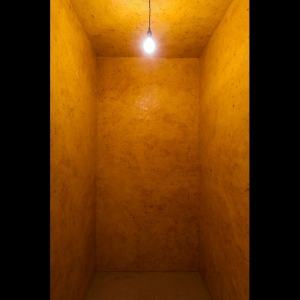
The Phillips Collection in Washington, D.C. will unveil its first permanent installation in over 50 years. Founded by the art collector and critic Duncan Phillips (1886-1966) in 1921, the Phillips Collection is the United States’ first modern art museum.
The new addition to the institution is a room made entirely from beeswax titled Wax Room. The experimental piece is the work of Wolfgang Laib (b. 1950), a conceptual German artist who is well known for his sculptural works made from natural materials. Laib has been making his beeswax chambers for over 25 years using hundreds of pounds of melted beeswax to coat walls and ceilings. The otherworldly spaces he creates are warmly lit by single hanging light bulbs.
The Phillips Collection’s other permanent installation is its Rothko Room, which holds four paintings by the abstract expressionist painter Mark Rothko (1903-1970). The intimate presentation of Rothko’s works was added as a permanent exhibit in 1960, six years before Duncan Phillips’ death. Phillips worked closely with Rothko, deciding which walls to hang each painting on and the kind of lighting and furniture that would best suit the room. The Phillips Collection was the first American museum to dedicate a space to Rothko’s work and it remains the only one designed in collaboration with the artist himself.
Laib’s progressive work is a welcomed addition to the Phillips Collection. While Phillips’ holdings consisted of many Impressionist paintings and other mainstream works, he also had a taste for the unconventional. Phillips was one of the earliest patrons of American modernists including John Marin (1870-1953) and Arthur Dove (1880-1946) and also harbored great admiration for Abstract Expressionism before it became a respected art movement.
Laib’s Wax Room will be unveiled on March 2, 2013.
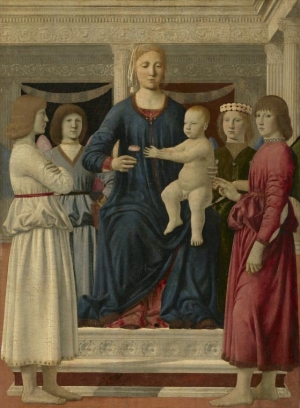
Seven works by the renowned Italian painter Piero della Francesca (1411/13-1492) are currently on view at the Frick Collection in New York. Piero della Francesca in America is the first monographic exhibition in the United States to focus on Piero, one of the founding figures of the Italian Renaissance.
Among the seven works on view at the Frick are six panels from the Sant’Agostino altarpiece (1454-69), a work commissioned for the Church of St. Agostino in Piero’s native Borgo San Sepolcro. Soon after the altarpiece was completed, it was dismantled, removed from the church, and the panels dispersed. Eight panels survive to this day including the four belonging to the Frick, three more, which are housed in European museums, and another belonging to the National Gallery in Washington, D.C.
The Frick’s reunion of the six panels is the largest reassembly from Piero’s masterpiece ever to appear on display. The panels are accompanied by the Virgin and Child Enthroned with Four Angels (circa 1460-70), the only intact altarpiece by Piero in the United States. Acquired by Sterling Clark (1877-1956), the heir to the Singer Sewing Machine fortune and an avid art collector in 1913, the work is now part of the Sterling and Francine Clark Institute’s collection in Williamstown, MA.
The exhibition, which is on view in the Frick’s oval room, is accompanied by a number of lectures, gallery talks, and seminars. Piero della Francesca in America will be on view through May 19, 2013.

French president Francois Hollande has given special allowance to Édouard Manet’s (1832-1883) Olympia (1863), permitting the masterpiece to travel from Paris to Venice for an exhibition. It will be the first time the influential painting has left the French city since it was given to the nation in 1890. Olympia, which features a nude woman and her fully clothed maid, shocked audiences with its subject’s provocative gaze and the suggestion that she was a prostitute.
Olympia, which is part of the Musée d’Orsay’s collection, will travel to Italy to anchor an exhibition at the Doge’s Palace in Venice. The painting will appear alongside Titian’s (1485-1576) The Venus of Urbino (1538), which is on loan from Florence’s Uffizi Gallery, as part of the exhibition Manet: Return to Venice. The exhibition features 70 works including 42 paintings by Manet on loan from the Musée d’Orsay, which will received a considerable amount in fees for the unprecedented loan. A number of paintings will also be on loan from the Metropolitan Museum of Art in New York.
Manet: Return to Venice will explore how Italian artists such as Vittore Carpaccio (1460-1520), Antonello da Messina (1430-1479), and Lorenzo Lotto (1480-1556) influenced the French painter. The exhibition will be on view from April 25 to August 4, 2013.
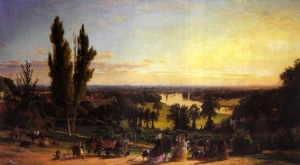
Days after the British government placed an export ban on two important works by the English painter, George Stubbs (1724-1806), officials have announced that they will take similar measures to keep a landscape painting of a London park by American Hudson River School artist, Jasper Francis Cropsey (1823-1900), in the U.K.
The export ban placed on Cropsey’s Richmond Hill in the Summer of 1862 gives the British government time to raise money to keep the painting in the country rather than having it sold to a foreign buyer. The government will need to come up with about $7.83 million in order to keep the painting, which has been in British collections for 150 years, in the U.K. Richmond Hill is important to British culture because it draws connections between American and British landscape paintings of the 19th century. It is one of the only British landscapes by an American artist to remain in the U.K.
The export ban will keep the Cropsey painting in the U.K. until April 7, 2013 and may be extended to August 7, 2013 if a potential British buyer has been found. The British government placed a previous export ban on Richmond Hill in 2000.

Genre-defying painter, sculptor, and illustrator, Richard Artschwager (1923-2013), died February 9, 2013 in Albany, NY. He was 89.
Artschwager, who was often linked to the Pop Art movement, Conceptual Art, and Minimalism, resisted classification through his clever genre mixing. His most well known sculpture, Table with Pink Tablecloth (1964) is an amalgamation of Pop Art and Minimalism and consists of a box finished in colored Formica, creating the illusion of a wooden table draped in a pink tablecloth. Artschwager often used household forms in his work including chairs, tables, and doors. In his paintings, Artschwager often painted black and white copies of found photographs and then outfitted them with outlandish frames made of painted wood, Formica or polished metal.
Artschwager was born in 1926 in Washington, D.C. and went on to study at Cornell University. In 1944, before he could finish his degree, he was drafted into the Army and sent to Europe. Upon returning to the United States after World War II, Artschwager completed his degree and decided to pursue a career in art. He moved to New York City and began taking classes at the Studio School of the painter Amédée Ozenfant, one of the founders of Purism. With a growing family and bills to pay, Artschwager took a break from making art to start a furniture-making business. After a fire destroyed his workshop, Artschwager returned to making art, developed his defining style, and was taken on by the Leo Castelli Gallery, which represented him for 30 years.
A few days prior to Artschwager’s death, the Whitney Museum of American Art in Manhattan closed a major career retrospective of his work. It was the second of its kind to be organized by the museum.
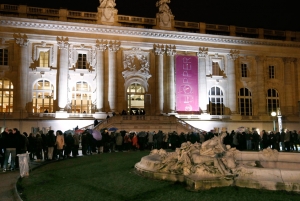
An Edward Hopper (1882-1967) retrospective, which was on view from October 10, 2012 to February 3, 2013 at the Grand Palais in Paris, welcomed a surprising number of visitors during its run. A total of 784,269 patrons visited the exhibition in less than four months, surpassing a blockbuster exhibition featuring the work of long-time Paris resident Pablo Picasso (1881-1973), which ran from 2008-2009 at the same French institution.
To accommodate the high number of visitors, the museum stayed opened around the clock during the show’s final weekend. 48,000 people visited the Grand Palais to catch a final glimpse of the Hopper show, including Jill Biden, the wife of US Vice President, Joe Biden.
The exhibition’s popularity came as somewhat of a surprise to museum officials as the American realist painter and printmaker has never drawn such a crowd in the United States. While he came close, Hopper was unable to surpass the popularity of the 2010-2011 Claude Monet (1840-1926) retrospective, which saw 913,064 visitors.
Hopper, who didn’t sell his first painting until he was 40, has grown considerably in popularity since his death at 85. Wildly successful exhibitions in Madrid, London, Milan, and Rome, which took place before Hopper’s show at the Grand Palais are a testament to the artist’s continued relevance.
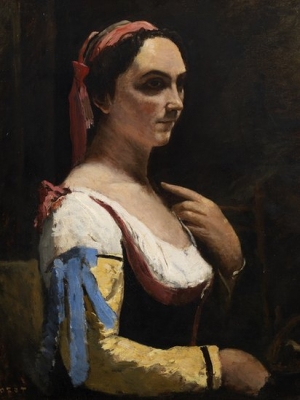
The late German-born British painter, Lucian Freud (1922-2011), specified in his will that his private art collection was to be donated to British museums rather than burdening his family with an inheritance tax after his death. The bequest is part of a British law that allows “acceptance in lieu” of taxes for authors, artists, and collectors.
Considered one of Britain’s greatest painters best known for his portraits and figurative works, Freud owned a number of important masterpieces including Jean-Baptiste Camille Corot’s (1796-1875) Femme á la Manche Jaune (The Italian Woman or Woman with Yellow Sleeve) and three bronze sculptures by Edgar Degas (1834-1917). It has been determined that the Corot painting, which has not been on public view in over 60 years, will go to the National Gallery in London and the Degas sculptures, Horse Galloping on Right Foot, La Masseuse, and Portrait of a Woman Head Resting on One Hand, will go to Somerset House’s Courtauld Gallery.
The donation is a thank you of sorts from Freud to Britain. The grandson of Sigmund Freud, Lucian escaped Hitler’s wrath when he came to England as a child. He became a British citizen in 1939.
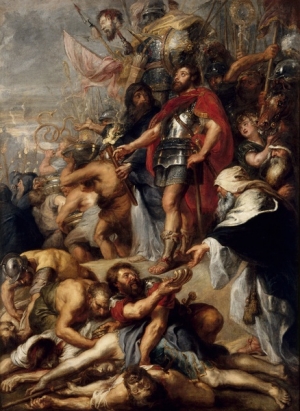
During the French Revolution, which lasted from 1789 to 1799, French troops took Flemish Baroque painter Peter Paul Rubens’ (1577-1640) The Triumph of Judas Maccabeus from the Tournai cathedral in Belgium. The work was whisked away to Paris and in 1801 it was sent to the Musée des Beaux-Arts in Nantes, France.
The Triumph of Judas Maccabeus is one half of a diptych that was commissioned for the cathedral by the bishop of Tournai in 1635. Napoleon’s army stole both The Triumph of Judas Maccabeus and its accompanying work, The Freeing of the Souls from Purgatory, which was returned to the cathedral in 1818.
Tournai officials are adamant about having the Rubens painting returned to the cathedral. Ruby Demotte, president of the French Community of Belgium, has penned a letter to French president Francois Hollande as well as to the French culture minister Aurélie Filippetti asking that the work be sent back to Belgium. Demotte made the same attempt last year but never received a response from the French government.
Tournai recently completed a major renovation of its cathedral and are hoping to finally reunite the two Rubens paintings.
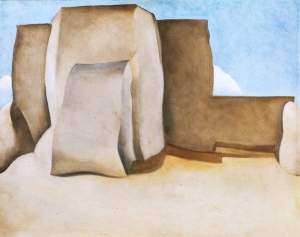
On view at the Montclair Art Museum in New Jersey through January 20, 2013, Georgia O’Keeffe in New Mexico: Architecture, Katsinam, and the Land focuses on Georgia O’Keeffe’s (1887-1986) life from 1929 to 1953. During this time, O’Keeffe lived in New Mexico and found herself enthralled by her surroundings as well as the Native American and Hispano cultures of the region.
While O’Keeffe’s early career as one of the first American abstract painters and her relationship with American photographer and art dealer Alfred Stieglitz (1864-1946) have been examined at length, O’Keeffe’s time in New Mexico has been less studied. The exhibition at the Montclair Art Museum features over 30 paintings and works on paper depicting New Mexico’s local architecture and landscape. From 1931 to 1945, O’Keeffe created numerous drawings, watercolors, and paintings of Kachina dolls (or Katsinam), which are carved representations of Hopi spirit beings. The exhibition includes 15 of these works, which are presented alongside actual Kachina dolls.
The Montclair Museum of Art will compliment Georgia O’Keeffe in New Mexico with a small presentation of three O’Keeffe works from a private collection including two oil paintings, Black Petunia and White Morning Glory 1 and Inside Clam Shell, and one pastel on paper, titled Pink Camellia.
The exhibition at the Montclair Art Museum was organized by the Georgia O’Keeffe Museum in Santa Fe, New Mexico and will travel to the Denver Art Museum (February 10-April 28, 2013), the Georgia O’Keeffe Museum (May 17-September 8, 2013), and the Heard Museum in Phoenix, Arizona (September 27, 2013-January 12, 2014) after its run in New Jersey.

London’s Tate Modern announced that 5.3 million patrons visited the museum in 2012, a record for the institution. In fact, the number of visitors was up a considerable 9.5 percent from the previous year.
An exhibition devoted to the work of contemporary artist Damien Hirst (b. 1965), which ran from April 4 to September 9, 2012, contributed significantly to the Tate’s record attendance. The show, which featured some of the controversial artist’s best-known works, attracted 463,000 visitors making it the most popular solo show ever organized by the museum. The Tate’s recently opened performance space, The Tanks, also contributed to the increase in patrons. The Tanks, which opened in July, is a permanent space for not only performance, but installations and video art as well.
Tate Modern, which opened in 2000, is Britain’s national museum for modern and contemporary art. Located along the Thames River in the former Bankside Power Station, the museum expects another stellar year. Exhibitions planned for 2013 include a major retrospective of the pop artist Roy Lichtenstein (1923-1997) and a show devoted to Swiss-born painter Paul Klee (1879-1940).
|
|
|
|
|